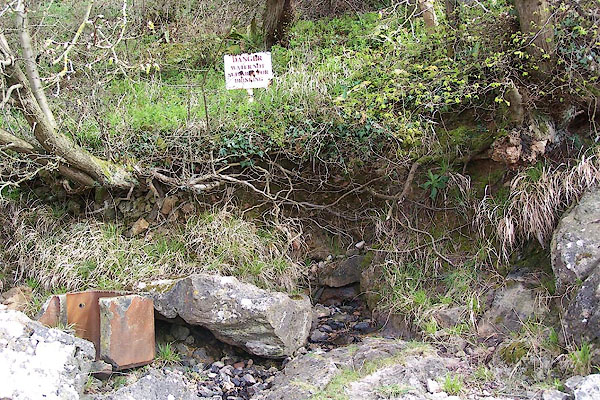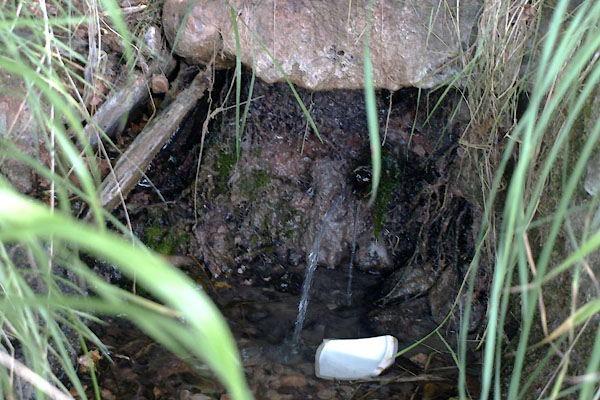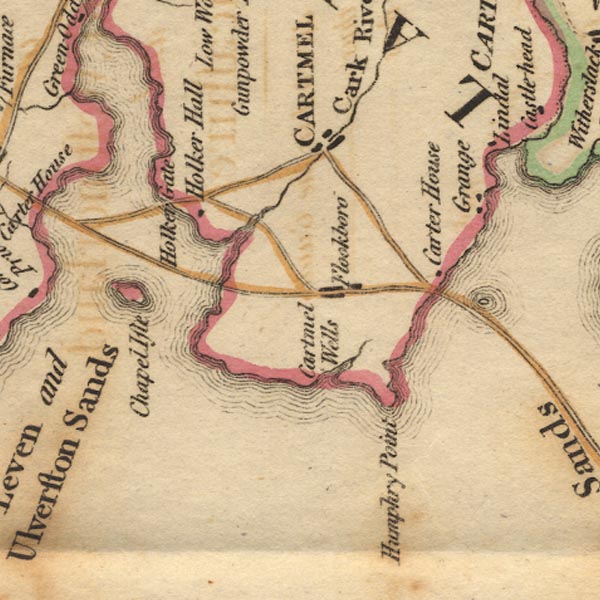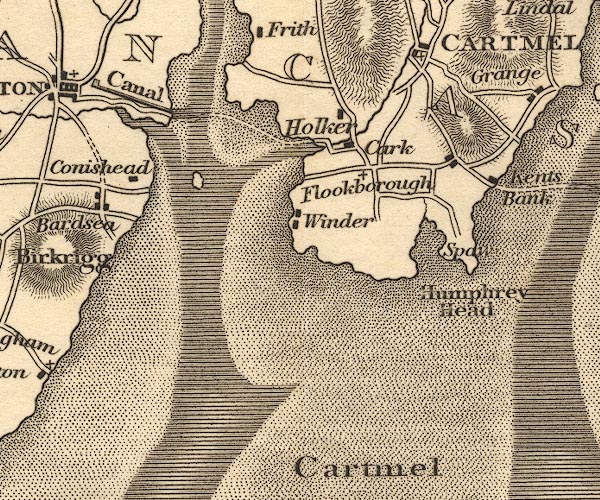 |
 |
   |
|
|
|
Holy Well |
|
Holy Well Spa |
|
St Agnes's Well |
| site name:- |
Humphrey Head |
| civil parish:- |
Lower Allithwaite (formerly Lancashire) |
| county:- |
Cumbria |
| locality type:- |
spring |
| locality type:- |
well |
| locality type:- |
spa |
| locality type:- |
holy well |
| coordinates:- |
SD39027391 |
| 1Km square:- |
SD3973 |
| 10Km square:- |
SD37 |
|
|
|

BLW25.jpg An unkempt and unholy well, we don't think we found the wrong place. The notice says:-
"DANGER WATER NOT SUITABLE FOR DRINKING" (taken 18.4.2006)

BYS46.jpg Notice the sherd of a broken mug.
(taken 5.7.2013)
|
|
|
| evidence:- |
old map:- OS County Series (Lan 17 15)
placename:- Holy Well Spa
|
| source data:- |
Maps, County Series maps of Great Britain, scales 6 and 25
inches to 1 mile, published by the Ordnance Survey, Southampton,
Hampshire, from about 1863 to 1948.
|
|
|
| evidence:- |
old text:- West 1774
|
| source data:- |
Book, with map and prints, The Antiquities of Furness, by Thomas West, Tytup Hall,
Furness, Lancashire, printed by T Spilsbury, Cook's Court, Carey Street, Lincon's
Inn, London, 1774; published 1774-1822?
 goto source goto source
Page 15:- "Near the sand-side stands Wraysholme tower: formerly it belonged to the Harringtons.
Near it is a medicinal spring of a brackish taste, much frequented every summer, and
found to be a good remedy for worms, and cutaneous complaints."
"..."
|
|
|
| evidence:- |
descriptive text:- West 1778 (11th edn 1821)
item:- cutaneous diseases
|
| source data:- |
Guide book, A Guide to the Lakes, by Thomas West, published by
William Pennington, Kendal, Cumbria once Westmorland, and in
London, 1778 to 1821.
 goto source goto source
Page 31, footnote:- "Near this place [Flookburgh] is a noted spaw, called Holy-well, found to be of great
service in most cutaneous disorders, and much resorted to in the summer season from
distant parts. It is an easy cathartic, restores lost appetite, and fully answers
the ancient poetic description of a fountain."
"'Infirmo capiti fluit utilis, utilis alvo.'"
|
|
|
| evidence:- |
old map:- West 1784 map
placename:- Cartmel Wells
|
| source data:- |
Map, hand coloured engraving, A Map of the Lakes in Cumberland,
Westmorland and Lancashire, scale about 3.5 miles to 1 inch,
engraved by Paas, 53 Holborn, London, about 1784.

Ws02SD37.jpg
item:- Armitt Library : A1221.1
Image © see bottom of page
|
|
|
| evidence:- |
old text:- Camden 1789 (Gough Additions)
item:- arthritis; cutaneous disorders
|
| source data:- |
Book, Britannia, or A Chorographical Description of the Flourishing Kingdoms of England,
Scotland, and Ireland, by William Camden, 1586, translated from the 1607 Latin edition
by Richard Gough, published London, 1789.
 goto source goto source
Page 142:- "..."
"Near Wraysholme tower is a brackish medical spring much used for arthritic and cutaneous
disorders."
|
|
|
| evidence:- |
old map:- Otley 1818
|
| source data:- |
Map, uncoloured engraving, The District of the Lakes,
Cumberland, Westmorland, and Lancashire, scale about 4 miles to
1 inch, by Jonathan Otley, 1818, engraved by J and G Menzies,
Edinburgh, Scotland, published by Jonathan Otley, Keswick,
Cumberland, et al, 1833.

OT02SD37.jpg
"Spaw"
item:- JandMN : 48.1
Image © see bottom of page
|
|
|
| evidence:- |
descriptive text:- Otley 1823 (5th edn 1834)
|
| source data:- |
Guide book, A Concise Description of the English Lakes, the
mountains in their vicinity, and the roads by which they may be
visited, with remarks on the mineralogy and geology of the
district, by Jonathan Otley, published by the author, Keswick,
Cumberland now Cumbria, by J Richardson, London, and by Arthur
Foster, Kirkby Lonsdale, Cumbria, 1823; published 1823-49,
latterly as the Descriptive Guide to the English Lakes.
 goto source goto source
Page 94:- "Flookborough ... has two comfortable inns fitted for the reception of persons making
use of a medicinal spring near Humphrey Head, two miles distant. This water is considered
a mild and safe purgative; and were a suitable accommodation erected upon the spot,
there would be no doubt of its becoming a place of considerable resort. ..."
|
|
|
| evidence:- |
descriptive text:- Ford 1839 (3rd edn 1843)
placename:- Holy Well
|
| source data:- |
Guide book, A Description of Scenery in the Lake District, by
Rev William Ford, published by Charles Thurnam, Carlisle, by W
Edwards, 12 Ave Maria Lane, Charles Tilt, Fleet Street, William
Smith, 113 Fleet Street, London, by Currie and Bowman,
Newcastle, by Bancks and Co, Manchester, by Oliver and Boyd,
Edinburgh, and by Sinclair, Dumfries, 1839.
 goto source goto source
Page 3:- "..."
"... The town [Cartmel] is chiefly supported by its mineral spring, called Holy Well,
three miles south of the town, celebrated as a remedy for stone, gout, and cutaneous
complaints. The water flows from a projecting rock of limestone, called Humphrey Head,
and its healing qualities cause a considerable influx of visitors from the neighbouring
places."
 goto source goto source
Page 154:- "..."
"[Cartmel] ... Three miles hence is a medicinal spring, called Holy Well, much fre[quented.]"
|
|
|
| evidence:- |
old text:- Jopling 1843
placename:- Holy Well
placename:- Cartmel Well
item:- stone, the; gout; cutaneous complaints; sulphate of lime; sulphate of magnesia; muriate of soda; calcium sulphate; magnesium sulphate; sodium chloride
|
| source data:- |
Book, Sketch of Furness and Cartmel, by Charles M Jopling,
published by Whittaker and Co, Ave Maria Lane, London and by
Stephen Soulby, Ulverston, Cumberland, 1843.
"THE SPA."
"The medicinal qualities of the 'Holy Well,' or Cartmel Well, at Humphrey Head, the
southern-most part of Cartmel, where it projects into the Bay of Morecambe, occasions
a considerable influx of company, during the summer months, to the town of Cartmel
and the neighbouring villages of Flookburgh, Kent's Bank, and Grange. The spring is
celebrated as a remedy for the stone, gout, and cutaneous complaints. A pint of the
water being evaporated, the solid contents were dried, by a heat rather inferior to
redness, and weighed sixty-two grains, which contained the following proportions:
sulphate of lime, 10, sulphate of magnesia, 2; muriate of soda, 49 [Charnock's analysis]."
|
|
|
| evidence:- |
descriptive text:- Palmer 1926
|
| source data:- |
Guide book, Things Seen at the English Lakes, by William T
Palmer, published by Seeley, Service and Co, 196 Shaftesbury
Avenue, London, 1926.
"... its waters should not be tasted by the wanderer. They have drastic action at times!"
|
|
|
|

BYS45.jpg Notice the sherds of a broken mug.
(taken 5.7.2013)
|
|
|
hearsay:-
|
The well was dedicated to St Agnes. Miners thought it effective against their diseases.
|
|
|







 goto source
goto source goto source
goto source
 goto source
goto source
 goto source
goto source goto source
goto source goto source
goto source
